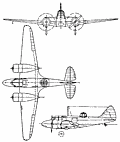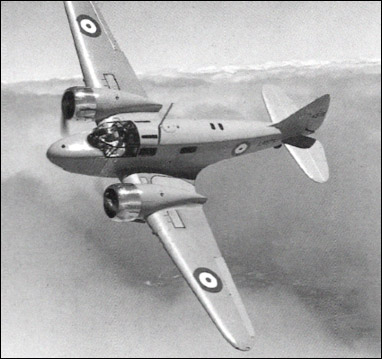|
| The 'Ox-box', as the Oxford became known to members of the RAF, was originally designed as a military development of the Envoy and was built to an Air Ministry specification of 1936. The prototype flew for the first time on 19 June 1937. The first production Oxfords entered service at the Central Flying School in November 1937 as the RAF's first twin-engined cantilever low-wing monoplane trainer. A total of well over 8,500 Oxfords were eventually produced by Airspeed and several sub-contractors and served in training, communications, ambulance and other roles.
Airspeed produced five basic versions of the design for military use, of which three were major types. The Mk I was a weapons trainer, usually
fitted with a dorsal gun turret; the Mk II a pilot, radio-operator and navigator trainer; and the Mk V, which was similar to the Mk II but powered by two 335kW Pratt & Whitney Wasp Junior radial engines. Large numbers of Oxfords were delivered to the air forces of Australia, Canada, New Zealand, South Africa, Southern Rhodesia and Portugal, as well as to the Fleet Air Arm, the USAAF and the Free French. A small number of civil Oxfords were also produced (not including military conversions), operated post-war by companies, airlines and flying clubs.
 | A three-view drawing (650 x 771) |
| ENGINE | 2 x Pratt & Whitney R-985-AN6 Wasp Junior, 336kW |
| WEIGHTS |
| Take-off weight | 3269 kg | 7207 lb |
| Empty weight | 2572 kg | 5670 lb |
| DIMENSIONS |
| Wingspan | 16.26 m | 53 ft 4 in |
| Length | 10.52 m | 35 ft 6 in |
| Height | 3.38 m | 11 ft 1 in |
| Wing area | 32.33 m2 | 348.00 sq ft |
| PERFORMANCE |
| Max. speed | 325 km/h | 202 mph |
| Ceiling | 6400 m | 21000 ft |
| Range | 1127 km | 700 miles |
| David French, e-mail, 15.05.2015 02:41 Rob,
If you see this can you please contact me as we are about to start our restoration and would like to ask a few questions please. reply | | Ken Wella, e-mail, 07.02.2015 20:20 Comment on crash at Lossiemounh. I had a fright, the hiss to the south of ud were our low flying area, one day I was flying I thought reasonably low, whwn a Shack from Lossiemouth came out of a valley at right angle and passed underneath me. reply | | Ken Wella, e-mail, 07.02.2015 20:17 I was staioned at RAF Dalcross (inverness) to convert from Chipmunk to Oxford in May 1952. Do not do very well and failed the course, in spite of coming top in my Chipmuk course. Part of th the trouble was height, at 5ft 6, I could only get full rudder on with the seat fairly well forward, tha meant I had troublr getting the control column back fsr enough for three point landings, and also had trouble getting enough rudder on quickly to control swings on take off, reply |
| Klaatu83, e-mail, 17.08.2014 17:27 It is a little-known fact that, during the Iraq "Rebellion" of April 1941, when the Iraqi government fell to a coup d'état, a number of Airspeed Oxfords that were stationed in Iraq at the time were pressed into service as bombers. I believe that was the only occasion when Oxfords were actually used in combat. reply | |
| | Klaatu83, e-mail, 17.08.2014 17:17 In addition to becoming a successful fiction writer Nevil Shute Norway, who designed the aircraft shown here, wrote a fascinating non-fiction account of his experiences in the British aircraft industry. Entitled "Slide Rule", it is highly recommended to those interested in this website. In addition to his experiences with Airspeed Ltd., he also discusses his earlier experiences with Vickers, where he worked on the design and construction of the airship R-100. His discussion of the R-100 and it's ill-fated competitor, the infamous R-101, coming as they do from one who was on the "inside" and was really privy to what was going on at the time, are highly enlightening. reply | | Don Stewart, e-mail, 02.08.2014 18:55 I believe that the first fatal crash from RAF Lossie on 1st Aug 1939 involved Oxfords, but I cannot find an official reference. See Youtube /Lossie History. reply |
| bill oakey, e-mail, 02.07.2013 23:31 The development of this aircraft and all of Airspeed products is wonderfully covered in Nevil Shute (Norway)'s autobiography titled "Slide Rule". reply | | Gary Hillman, e-mail, 29.11.2012 22:05 I am the Vice President of the Harvard Historical Aviation Society in Penhold, Alberta, Canada, who have recently found the remains of a MkV Oxford and then discovered it had actually served as a trainer at our airport in Penhold during the war. We intend to restore this aircraft to at least display status if not flying status in the future and would like to communicate with those with such experience as well as anyone who has flown one. reply | | kevin cranley, e-mail, 05.05.2012 10:15 I flew OXFORDS at Little Rissington and Chipping Norton I really enjoyed flying the Oxford.Subsequently I was posted to 27 OTU Lichfield Bomber Command.I did not enjoy the Wellington and had a prang in a fog at nightime reply | | kevin cranley, e-mail, 05.05.2012 10:15 I flew OXFORDS at Little Rissington and Chipping Norton I really enjoyed flying the Oxford.Subsequently I was posted to 27 OTU Lichfield Bomber Command.I did not enjoy the Wellington and had a prang in a fog at nightime reply | | jim wingett, e-mail, 26.01.2012 18:13 Hello David Thomas
I seem to remember the "Boost" button delivered a really fat spark during start up. Dear old Oxfords eh? reply |
| Klaatu83, e-mail, 05.03.2011 04:00 Based on a design by Nevil Shute Norway, who later became a novelist, writing such well-known books as "On The Beach", "No Highway in the Sky" and "A Town Called Alice". reply | | David Thomas, e-mail, 05.02.2011 05:49 I trained on Oxfords at Point Cook in 1944 and recall starting the engines involved pressing a "Boost" button...was never too sure what this actually did...any suggestions? reply | | Martin Shelley, e-mail, 05.02.2011 03:43 I am the Marque Specialist for OEC motorcycles in the Vintage Motorcycle Club (VMCC). During research for a book on these machines, I came across wartime work by their maker, the Osborne Engineering Company of Portsmouth and Gosport, who produced tubular steel struts to lock the undercarriage of Airspeed Oxfords which were apparently prone to U /C collapsed on careless landing. These struts were fitted as a remedy although the result was non-retracting U /C. Would be pleased to hear more from anyone with experience of this modification. reply | |
| | Ken Hindle, e-mail, 19.12.2010 11:05 I am a co-ordinator in Werribee,Australia,currently
re-building a B24Liberator. Our new venture which is in its infancy, is to buicd an Airspeed Oxford. All information,detail pictures ecetera we are always looking for. Kindly keepus in mind. Regards Ken Hindle reply | | Rob tribelhorn, e-mail, 19.09.2010 16:29 I am in the process of restoring GAITF the aircraft swapped for a SAAF Ventura in 1984 at the SAAF Museum Port Elizabeth South Africa. It is painted in the trainer yellow that was used here at 42 Air Training school during WW2. Lots of work to still be done as I started work on her in 2004. reply | | Rob Tribelhorn, e-mail, 25.07.2010 23:01 I have restored the oxford at the SAAF Museum in Port Elizabeth to the stage where it is in the colours of the trainers at WW2 42 Air School P.E. South Africa (Mid chrome yellow )The internals still require a lot of work. Both Cheetah X motors fitted.Both motors have been overhauled Port motor has run Starboard motor yet to run. reply |
|
Do you have any comments?
|
| 
COMPANY
PROFILE
All the World's Rotorcraft
|








 Don Stewart
Don Stewart
Hi Ken,
Hopefully this gets through to you. My father was at Dalcross but not until Feb 1953, were you still there then and if so do you remember Michael Simpson?
Regards, Paul (his eldest son)
reply